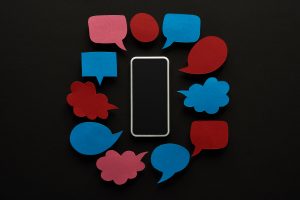Andressa Oliveira

In the same year that former U.S. President Donald Trump got deplatformed – banned from major social media sites like Twitter and Facebook – the technology industry hit the headlines again with the Taliban’s social media presence. Despite the Taliban’s history of oppression and violence, specifically against women and ethnic minorities, the “new Taliban” are changing their rhetoric by spreading the message of inclusion and peace through a “diplomatic charm offensive.” While some may suggest it might be too early to know if the Taliban have changed, it is clear that they are different in one important way: The Taliban have embraced technology, social media, and communication strategies for their own benefit.
At this point, it may be too early to know what type of leaders are coming to power. The gut instinct may be to deplatform the Taliban. However, banning specific actors from mainstream social media platforms does not make these groups suddenly disappear. Additionally, such actions may fuel polarization and intensify tensions at a global level. At this moment, it is also unclear if the technology companies are able to be consistent in their policy and enforcement operations. No matter the platforms’ decisions about the Taliban, or any other specific actor, their actions will always reverberate in places far from their headquarters in California.
The question should not be about deplatforming the Taliban or not; instead, it should be a question of who gets to make such decisions. Certainly, the technology companies have complete control over who they want on their platforms. After all, these are for-profit companies that will focus on their own financial and political interests. Yet if social media remains a crucial tool in politics, who gets to be on platforms may be a decision that neither technology companies nor governments are well positioned to make. Therefore, this is an opportunity to reassess the technology industry’s role outside their headquarters and establish a new strategy that considers those who face the sociopolitical repercussions of the decisions made by the platforms.
Myanmar has provided many lessons on the effects of U.S. social media on foreign affairs. In 2018, Facebook admitted to “not doing enough” by failing to prevent division and incitement of violence against the Rohingya Muslims. In April, after the military coup of February 2021, Facebook decided to ban Myanmar’s armed forces from the platform based on their history of human rights abuse, disinformation campaigns, and risks of offline harm. However, even after that action, Facebook kept inviting users to like pages that share pro-military propaganda.
When it comes to the Taliban, the group is not new to social media. They have been establishing a social media presence for years by posting content in different languages with the aim to “win over the minds and hearts of the masses.” Their Twitter presence goes back to 2011, and in 2016 the group created a WhatsApp helpline in Afghanistan. Today, Facebook, YouTube (part of Alphabet Inc.) and TikTok all ban Afghan Taliban accounts in accordance with U.S. economic sanctions. Twitter still allows the group to post content. In addition, the content shared by the group rarely violates stated policies, which poses challenges for companies when it comes to removing Taliban content. Meanwhile, the Tech Against Terrorism group, an U.N.-backed initiative, has added the Afghan Taliban to its list of terrorist organizations and has recommended that technology companies remove or restrict their access.
Nevertheless, the New York Times reported that since August 9, more than 100 new accounts and pages, either claiming to belong to the Taliban or supporting their mission, have been created on Facebook and Twitter. Social media platforms may face the reality of playing a whack-a-mole game against the Taliban. Some platforms have been taking actions to protect users in Afghanistan. However, it is unclear how long these companies can maintain such operational process changes sustainably and in a way that keeps people safe and does not create sociopolitical disruption in the long run.
History has shown that propaganda and information control is part of the playbook of authoritarian and totalitarian rulers. It should not come as a surprise when, amid a political crisis, the official spokesman for the Taliban, Zabihullah Mujahid, took time to apply the same tactics used by many leaders in power to accuse Facebook of censorship. Mujahid’s discourse has been previously echoed by many authoritarian and totalitarian figures around the world. These regimes use social media as the battlefield for their own political interests, resulting in real-world violence. The U.S. technology industry is particularly in the spotlight in this regard due to its overarching power at a global level. Therefore, the questions about the Taliban’s social media presence should be broader in scope and focus on the general impact of the technology platforms on foreign affairs. Ultimately, users outside the boundaries of wealthy Western nations are the ones suffering from the actions taken by U.S. platforms.
In this sense, Marietje Schaake, international policy director at Stanford University, called for a global democratic alliance that removes the privatized power of the technology companies. This alliance, Schaake envisions, would be empowered “to set norms, rules, and guidelines for technology companies and to agree on protocols for cross-border digital activities.” Extrapolating from Schaake’s views it is time to restrict the power of the technology industry in foreign matters – regardless of regime type – and call for an independent international coalition led by civil society and netizens who can directly decide what happens across the technology platforms and within the boundaries of their nations.
If the technology industry wants to be seen as morally responsible actors in the four corners of the world, it is time to reconsider the current decision-making model.
No comments:
Post a Comment